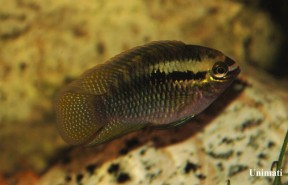Laetacara dorsigera
Redbreast Acara
SynonymsTop ↑
Acara dorsiger Heckel, 1840; Aequidens dorsiger (Heckel, 1840)
Etymology
Laetacara: from the Latin laetus, meaning ‘happy’, and acará, a vernacular term used for cichlids in certain parts of South America, in reference to patterning around the mouth and snout which give members of this genus a ‘smiling’ appearance.
Classification
Order: Perciformes Family: Cichlidae
Distribution
Currently accepted to occur in the rio Guaporé in Bolivia (where the river is known as the Río Iténez) and western Brazil plus the Paraná drainage system in southern Brazil, Paraguay and Argentina and rio Uruguay in Rio Grande do Sul state, southern Brazil, with some populations exhibiting differences in colour pattern to one another.
Type locality is ‘Villa Maria, Río Paraguay, South America’.
Maximum Standard Length
36.9 mm.
Water Conditions
Temperature: 20 – 28 °C
pH: 5.0 – 7.5
Hardness: 36 – 268 ppm
Diet
Wild fish are probably foragers feeding on algae, organic detritus, small insects, worms, crustaceans, and other zooplankton.
In the aquarium it’s easily-fed but the best condition and colours offer regular meals of small live and frozen foods such as bloodworm, Daphnia, and Artemia, alongside good quality dried flakes and granules, at least some of which should include additional plant or algal content.
Reproduction
Biparental substrate spawner.
NotesTop ↑
The genus Laetacara currently contains seven valid species and L. curviceps can be told apart from all congeners except L. thayeri and L. flamannellus, by having fewer scales in the longitudinal series (21–22 in L. dorsigera vs. 24 in L. flavilabris, 22–24 in L. curviceps and 23–25 in L. fulvipinnis, L. minutacara and L. araguaiae).
In addition it can be distinguished from congeners except L. curviceps and L. flamannellus by having a dark spot on the middle of the dorsal-fin.
Laetacara dorsigera is distinguished from L. araguaiae and L. curviceps by having higher head depth (head depth 90.2–96.3 % mm HL in L. dorsigera vs. 84.6–88.9 % mm HL in L. curviceps and 80.0–87.1 % mm HL in L. araguaiae), from L. thayeri by having cycloid scales on the sides of the head (vs. ctenoid scales) and more anal-fin rays (8–9 vs. 7–8), from L. flavilabris by possessing fewer total vertebrae (24 vs. 26) and fewer scales in the upper lateral line (14–15 vs. 15–18), from L. fulvipinnis by having fewer scales in the upper lateral line (14–15 vs. 15–17), fewer scales on the lower lateral line (6–8 vs. 8–9) and absence of a dark dot at the edge of each scale on the midlateral portion of the flank (vs. presence), from L. curviceps by having a wide ectopterygoid (vs. a narrow ectopterygoid), more dorsal-fin rays (9–10 vs. 8–9) and breeding males and females with conspicuous red cheeks, opercula and belly (vs.no such colour pattern), and from L. flamannellus by absence (vs. presence) of an orange-coloured ring around the dorsal-fin spot.
References
- Ottoni, F. P. and W. J. E. M. Costa, 2009 - Vertebrate Zoology 59(1): 41-48
Description of a new species of Laetacara Kullander, 1986 from central Brazil and re-description of Laetacara dorsigera (Heckel, 1840) (Labroidei: Cichlidae: Cichlasomatinae). - Ottoni, F. P., J. L. O. Mattos and I. Schindler, 2009 - Vertebrate Zoology 59(2): 123-129
Re-description of Laetacara curviceps (Teleostei: Cichlidae: Cichlinae). - Ottoni, F. P., P. H. N Bragança, P. F. Amorim and C. S. Gama, 2012 - Vertebrate Zoology 62(2): 181-188
A new species of Laetacara from the northern Brazil coastal floodplains (Teleostei: Cichlidae). - Staeck, W. and I. Schindler, 2007 - Vertebrate Zoology 51(1): 63-71
Description of Laetacara fulvipinnis sp. n. (Teleostei: Perciformes: Cichlidae) from the upper drainages of the rio Orinoco and rio Negro in Venezuela.



